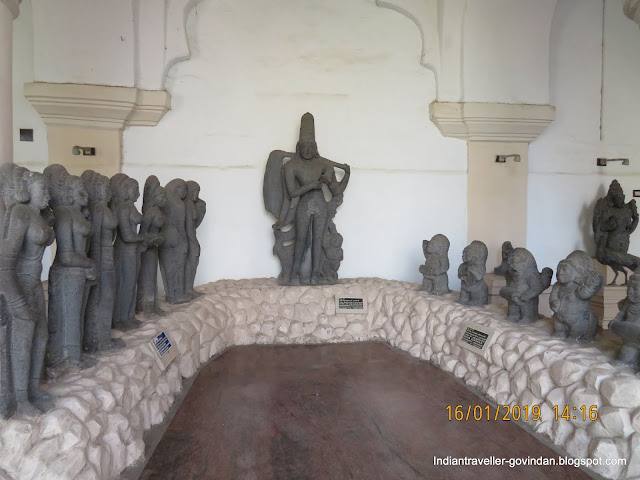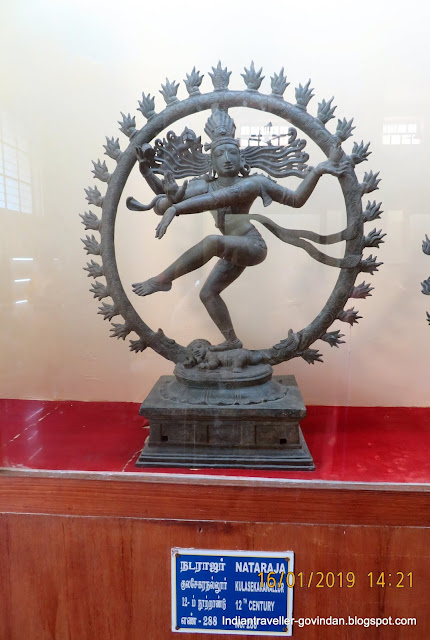BRAHADESWARA TEMPLE
 |
Brahadeswara Temple layout
|
The Brahadeswara Temple is in the center of the town and can be viewed from any corner of the town.This Shiva temple was built by King Raja Raja Chola (985-1012 AD).It is said that it took about 6 years to build this temple.This temple is referred as Big Temple ( Periya Kovil).
This temple has been declared as UNESCO heritage site. This temple was completed in the year 1010 and turned 1000 years old in 2010.
This is not a single temple but a
large temple complex more like a fort having multiple temple and shrines. We found a compound surrounding temple like fort walls.
The layout of the temple is shown in the photo above.
 |
| Details of Structures in Brahadeswara Temple |
Since the photo above is not very clear I am listing the structures in the temple complex as below:
1. Maratha Entrance 2. Keralantakan Tiruvasal 3. Rajarajan Tiruvasal 4. Nandi Mandapam 5. Varahi Shrine 6. South Cloister Mandapam 7. Brihadeeswarar Temple
8. Interpretation Centre 9. Ganesha Shrine 10.Karuvur Devar Shrine 11.Subrahmanya Shrine 12.Chandikesvara Shrine 13.North Cloister Mandapam 14.Amman Shrine
15. Nataraja Mandapam
We enter the temple through the Maratha Entrance which is the first gate.This was built during the Maratha rule as the name implies.Beautiful carvings can be seen at the entrance.
 |
| Maratha Entrance |
 |
Maratha Entrance
|
Once we cross the Maratha Entrance we come to the Keralanathan Tiruvasal. This was built by King Raja Raja Chola -1 to commemorate his victory over Cheras.
 |
Keralanathan Tiruvasal |
Once we cross the Keralanathan Tiruvasal is the Rajarajan Tiruvasal.This structure is made
of granite. This gopura has beautiful stone carvings depicting various episodes like the marriage of Siva and Parvati, Siva
protecting Markandeya, Arjuna winning the
pasupata weapon. This structure has two
massive stone carvings on the two sides which is beautiful.
.
 |
| Decorated Nandi |
Moving ahead, we come to the Nandi Mandapam.Here you can see a huge Nandi made out of a single granite stone and said to be second biggest in India. This is said to be done during 16th-17th century during the rule of Nayaks. The ceiling has beautiful paintings.The day we visited was Mattu Pongal festival and the Nandi was decorated with fruits and vegetables. The carvings in the pillars of Nandi Mandapam are intricate and beautiful. To the right of the Nandi Mandapam is the Nataraja Mandapam. This is a simple rectangular stone structure built as a covered hall. This structure was built around 1800 AD by the Marathas under Sarafoji II. Diagonally opposite to Nandi Mandapam is the Amman Shrine, built
around 13th century by the Pandyas.
Right in front of Nandi is the main temple of Lord Brahadeswara.

Many tamil inscriptions can be seen on the temple wall as shown in photographs below
|
Brahadeswara temple is within Thanjavur city and can be seen from any part of the city. The main deity here is Lord Brahadeswara (Shiva). The temple is said to be built by King Raja Raja Chola (985-1012 AD).
This has been declared as a World Heritage Monument by UNESCO and is maintained by ASI.
The Shivalingam here is 58 feet in circumference and 12 feet high. This is a smaller Shivalingam when compared to the idol in Gangaikonda Cholapuram. Since we visited on a festival day large crowd was there and we had to stand in queue for a long time for darshan.
This is a regular temple with Poojas.
It is said that the great traveller Marco Polo visited Thanjavur and this temple and his image can be seen in the outer walls of the temple.
The temple complex also has shrines of Ganesha, Subramania, Varahi, Karuvur Devar and Chandikeswara.
Ganesha Shrine is relatively a very small structure built by Sarabhoji at the end of 18th century. This structure is east facing and the idol inside is clearly visible from the raised platform.
To the right of Brihadeeswarar Temple, is the Chandikesvara Shrine built by the Nayaks in the 16th century.
Next to Chandikesvara Shrine is the Subrahmanya Shrine built by the Nayaks in the 17th century.
This is a small shrine next to the North Cloister Mandapam dedicated to the goddess Varahi.
In the North cloister mandapam we find navagrahas in the form of Shiva Lingas as in the photographs below.
In this blog, I have tried to appraise the visitors to this temple what to see, but much more can be written about this temple.
|
Hope this helps in planning the visit to this temple in Thanjavur. I will be posting a blog on other places to see in Thanjavur shortly.
|

































































